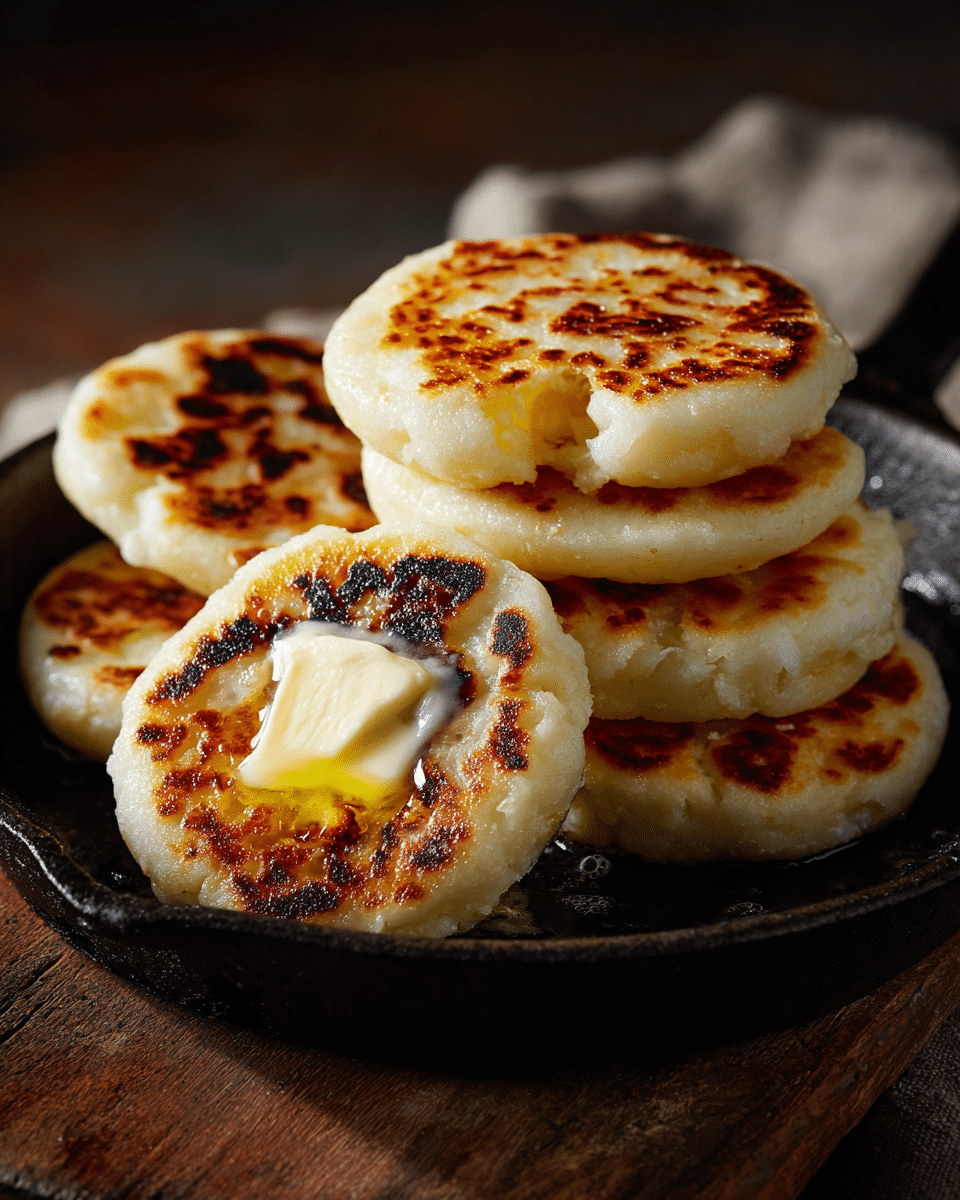Arepas con Queso are a beloved Latin American staple, especially popular in Colombia and Venezuela. These thick, cornmeal-based patties are infused with melted cheese, offering a crispy crust with a soft, gooey center. They can be enjoyed on their own, paired with eggs, or stuffed with meats and vegetables for a hearty meal.
FULL RECIPE
Ingredients
- 2 cups pre-cooked white cornmeal (masarepa)
- 1 ½ cups warm water
- 1 cup shredded mozzarella cheese (or queso blanco)
- ½ cup whole milk
- 2 tablespoons unsalted butter, melted
- ½ teaspoon salt
- Additional butter or oil for the griddle
Directions
- In a large bowl, mix the warm water, milk, melted butter, and salt until combined.
- Slowly add the masarepa while stirring continuously to avoid lumps. Let the mixture sit for 3–5 minutes to absorb the liquid.
- Fold in the shredded cheese and knead the dough until smooth and pliable. If it’s too dry, add a splash more milk; if too wet, add a bit more cornmeal.
- Divide the dough into 6 equal portions and shape each into a ball, then flatten into discs about ½ inch thick.
- Heat a lightly buttered or oiled griddle or non-stick skillet over medium heat.
- Cook the arepas for 4–5 minutes on each side until golden brown and crisp, and the cheese starts to melt inside.
- Optionally, finish them in a 350°F (175°C) oven for 10 minutes to ensure they are cooked through.
- Serve hot with butter, avocado slices, or your favorite salsa.
Nutrition Facts
- Calories: 240
- Total Fat: 10g
- Saturated Fat: 5g
- Cholesterol: 25mg
- Sodium: 280mg
- Total Carbohydrates: 30g
- Dietary Fiber: 2g
- Sugars: 1g
- Protein: 8g
Cultural Significance of Arepas con Queso
Arepas con Queso hold a cherished place in Latin American cuisine, particularly in Colombia and Venezuela. While arepas themselves have ancient indigenous origins, the cheesy variation has become a symbol of comfort and family-style eating. These griddled cornmeal patties are often served at breakfast or dinner and are seen as a unifying dish across regions. In Colombia, they are frequently enjoyed with hot chocolate, while in Venezuela, they may be part of a more elaborate meal. The cheese-stuffed version brings added indulgence to an already beloved classic, embodying warmth and tradition in every bite.
Nutritional Value and Health Benefits
Arepas con Queso can be a nourishing part of your diet when consumed in moderation. Made primarily with pre-cooked cornmeal, they provide complex carbohydrates that support sustained energy release. The cheese adds protein and calcium, essential for muscle function and bone health. When prepared with whole milk and a moderate amount of butter, they also supply healthy fats. For individuals on gluten-free diets, arepas offer a safe and satisfying alternative to wheat-based breads. Reducing the cheese or using a low-fat version can make this comfort food even more health-conscious without sacrificing flavor.
Popular Variations
There are many delicious ways to customize Arepas con Queso. In some regions, farmers’ cheese or queso blanco is used for a saltier, creamier filling. Others add sweet elements such as sugar or anise to the dough for a dessert-like arepa. Whole-kernel corn or chopped herbs like cilantro can be mixed into the dough for added texture and flavor. Some cooks slice the finished arepas and add fillings like shredded meat, beans, or eggs, creating a hearty sandwich-style meal. These variations demonstrate the adaptability of arepas to both savory and sweet palates.
Serving Suggestions
Arepas con Queso are incredibly versatile when it comes to serving. For breakfast, pair them with scrambled eggs or fried plantains. At lunch or dinner, they work beautifully alongside grilled meats, black beans, or fresh salad. As an appetizer, small arepas can be served with dips such as guacamole, pico de gallo, or garlic sauce. They also complement soups, especially brothy or spicy ones like sancocho or chicken stew. The melted cheese interior makes them satisfying enough to stand alone, but their mild flavor invites creative pairings.
Ideal Cheese Choices
The type of cheese you use can significantly affect the taste and texture of your arepas. Mozzarella is a popular choice due to its meltability and mild flavor. Queso de mano or queso costeño—traditional Latin cheeses—add authenticity and a salty bite. Monterey Jack, cheddar, or Oaxaca cheese are good alternatives depending on availability and preference. The key is selecting a cheese that melts well but doesn’t release too much oil, as excess moisture can affect the dough’s integrity during cooking. A blend of cheeses can also yield a richer, more complex flavor profile.
Cooking Techniques for Perfect Texture
Achieving the ideal texture in Arepas con Queso involves careful attention during cooking. A non-stick skillet or cast-iron griddle works best for creating a crisp, golden-brown crust while maintaining a soft, cheesy interior. Cooking over medium heat allows the arepas to brown evenly without burning or drying out. Pressing the dough to a uniform thickness helps ensure even cooking. For extra assurance that the inside is cooked through, some prefer to finish the arepas in a preheated oven after pan-grilling. This dual-method approach locks in flavor and guarantees a melt-in-your-mouth center.
Storage and Reheating Tips
Arepas con Queso are best enjoyed fresh, but leftovers can be stored effectively. Once cooled, place them in an airtight container and refrigerate for up to three days. To reheat, use a skillet over low heat to regain the crisp exterior while gently warming the cheese inside. Microwaving is an option for speed, but it may soften the crust. For longer storage, arepas can be frozen—place parchment paper between each to prevent sticking. Reheat from frozen by baking at 350°F (175°C) until heated through, approximately 15–20 minutes.
Pairing with Beverages
The mild corn and cheese flavors of Arepas con Queso pair well with a range of beverages. In Colombia, they’re traditionally served with a mug of hot chocolate, creating a sweet and salty harmony. Coffee—especially a strong espresso or café con leche—is another popular match. For a refreshing cold drink, try them with fresh juices like mango, guava, or passion fruit. If serving arepas at lunch or dinner, light beers or sparkling wines can complement the dish’s richness. The key is to balance the creamy interior with a beverage that refreshes the palate.
Gluten-Free and Allergen Notes
One of the major benefits of Arepas con Queso is that they are naturally gluten-free, making them a safe and satisfying option for those with gluten sensitivities or celiac disease. Made with masarepa, a pre-cooked corn flour, they avoid the pitfalls of wheat-based doughs. However, the dairy content makes them unsuitable for those with lactose intolerance or dairy allergies. For a dairy-free version, plant-based cheeses can be substituted, though the melt and flavor may differ. Always verify ingredient labels, especially when serving individuals with dietary restrictions.
Why Arepas con Queso Are the Ultimate Comfort Food
There’s a reason Arepas con Queso are so beloved: they evoke a feeling of home and satisfaction. The combination of warm, griddled corn dough and gooey melted cheese hits all the right comfort notes. They are easy to make with minimal ingredients and can be adapted to suit a range of dietary needs and taste preferences. Whether eaten alone or with a full spread, they fill you up in a nourishing, heartfelt way. Their simplicity is their strength, making them a go-to dish when you need something cozy and reliable.
Conclusion
Arepas con Queso are more than just a meal—they’re a cultural experience, a comfort food classic, and a versatile canvas for culinary creativity. From their roots in Latin American kitchens to modern adaptations around the world, they continue to delight with their crisp exterior and luscious cheesy center.






